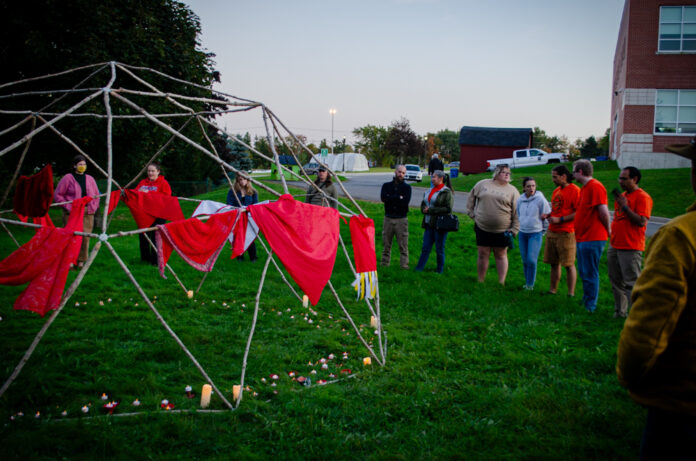
From Oct. 2 to 4, people gathered at various events held by University of New Brunswick’s Mi’kmaq Wolastoqey Centre in support of the Red Shawl Campaign.
The Red Shawl Campaign brings awareness to the murdered and missing Indigenous women in Canada, a number that keeps climbing.
According to Statistics Canada, the homicide rate for Indigenous women was six times higher than that amongst non-Indigenous women between 2009 and 2021.
“The shawl is a symbol of protection,” said campaign founder and former UNB Elder-in-residence Opolahsomuwehs. “Picture a grandmother wrapping you, your mother wrapping you, a sister wrapping you, an auntie wrapping you or even a father wrapping you and saying ‘you’re gonna be okay.’”
Red shawls could be seen displayed in an exhibit this year at the New Brunswick Provincial Archives, as well as at a candlelight vigil held by the UNB Longhouse on Oct. 4.
At the candlelight vigil, red shawls hung from the wooden sweat lodge structure as students placed LED candles in a circle on the ground. Candles were placed in red student-created candle-holders, each embossed with the name of an Indigenous woman or girl who went missing or was found murdered.
Each observer held a candle as Opolahsomuwehs spoke, and urged to send prayers and protection to a woman in need. The sun set, and the candle light grew brighter in the darkness — much like the spirit of the Red Shawl Campaign.
“We don’t have to go out there and shout out profanities to gain attention because that’s not how I want to tell the story,” she said. “I want to do it in the most human, heartfelt, passionate way, without having to raise my voice and or to be angry… that’s how I want to keep this campaign.”
The campaign started in 2015, with Opolahsomuwehs as the driving force along with then-student Natasha Martin-Mitchell. Martin-Mitchell took the lead in putting together the event and hung the shawls from the chosen space of UNB’s Memorial Hall in that first year.
Martin-Mitchell mentions getting most of the shawls at thrift stores or people finding shawls in their closets and gifting them for the ceremony. This year, the shawls were all handmade specifically for the event.
“It was so heartwarming to see the people stepping up and saying, ‘I want to be a part of this. How can I help?’” she said.
One of Martin-Mitchell’s standout memories of working with the Red Shawl Campaign was in her first year, when the group partnered with Atlantic Ballet Theatre of Canada to create an Indigenous-inspired ballet. Martin-Mitchell, who now works on the board for the ballet company, had the idea to paint the pointe shoes in a moccasin style for the performance.
“They were talking about the language, which is very important, and somehow integrating language into the ballet,” she said. “But for me, the pointe shoe was the connection to the ground, it was connection to the land.”
After she graduated in 2018, Martin-Mitchell was saddened to see the campaign lose traction. When she received a call this year that the campaign was returning, she was thrilled. Although she couldn’t work on campaign events this year, she hopes to come back and help out again, but also to pass the torch to younger generations.
“Space was created for me, so I know that it’s my job to create that space for someone else,” she said. “I like to say ‘a rising tide lifts all ships.’”
Similarly, Opolahsomuwehs emphasizes the importance of the younger generations in carrying on the work they’ve done to create a better future. She regularly works with children, teaching them the importance of their Indigenous language and culture.
Along with teaching children, Opolahsomuwehs is also guiding those who want to help teach and take care of their own communities. She reflects on her time naming babies, as well as giving older adults their spirit names.
“All of them are going to be dealing with carrying the responsibility of their spirit name,” she said. “And they have to know it’s not just getting a name. They have to know there’s work to be done in their communities.”
